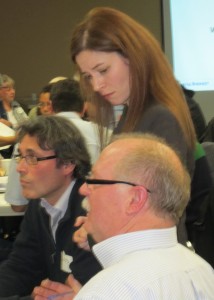March 23, 2014
BURLINGTON, ON.
Point: Notices were mailed to all the people in the rural community about a meeting to consider the idea of a special cultural/heritage district, unfortunately they went out a couple of days after the event. Turnout was less than expected.
Point: The city posts all kinds of detail on its website and develops stories encouraging people to consider running for public office – but, for reasons which were never made clear, they took down that portion of the web site that had all the financial returns from the 2010 municipal election.
The financial return is the document that sets out how much money each candidate raised, who the donours were and what the funds raised were spent on. Vital information for anyone who decides they want to run against an incumbent.
The documents have since been put back up on the city website. Why were they taken down and who made that decision?
Point: The city holds a public meeting on the budget the finance department has prepared. While there is just the one meeting held in the downtown core, it is well attended and staff are very attentive in answering questions. There is talk of plans for additional public meetings in 2015 in the Dundas part of town now that the Alton campus is operational.

The city had very competent staff on hand at public sessions to answer questions – on decisions that had already been made.
Vanessa Warren, one of the people who led the public reaction to the dumping of landfill on the airpark site on Appleby Line, asked why the city was coming to the public with spending that was already decided on. She wanted to know why the public wasn’t being asked how it wanted its money spent BEFORE decisions were made.
City manager Jeff Fielding, would dearly love to have feedback from the public on key issues and has devoted a significant part of the budget he has to run his office to a process that he hopes will give him almost instant access to a panel of people who can answers questions. The unfortunate part of this $100,000 + expense is that the public response has not been overwhelming – there were less than 500 people on the panel at last count.
It is a two-sided coin – the public wants information – well the more vocal part of the public wants more information, and the city is being moved in a direction where public input will be critical. Getting to a point where what the public wants and what the city would like is the challenge for the city.
Back in 2010 the late John Boich and former Mayor Walter Mulkewich authored the Shape Burlington report in which they identified an “information deficit” in the city. City hall didn’t take all that kindly to the report – a report on which they haven’t responded to all that well since its publication even though city council voted unanimously to support the document.
 Boich and Mulkewich recommend that there be a Citizens charter – a document that sets out what every citizen can expect from the city. There is such a document but you would be very hard pressed to find the thing on the web site and the “implementation plan” for that document has yet to be completed.
Boich and Mulkewich recommend that there be a Citizens charter – a document that sets out what every citizen can expect from the city. There is such a document but you would be very hard pressed to find the thing on the web site and the “implementation plan” for that document has yet to be completed.
Would it be fair to say that the administration at city hall isn’t really behind the concept of a charter other than collecting data and then doing nothing with it?
There is a demographic divide at city hall – both within the administration and at the council level. There are people in the planning department and over at finance who genuinely want the public to know what is being done and are eager to hear what people have to say.
The city manager certainly wants public input and is delighted when he meets people who can help him determine the public will. However, getting all of his senior team onside has been and is continuing to be a challenge.
There is an item on a Standing Committee agenda somewhere in the works that will discuss the Community Engagement plans; this doesn’t appear to be a priority item but then real community engagement has never been a priority for this city.
Two of the current city council members were on the Shape Burlington committee – one would think they would be chomping at the bit regularly to get some movement on the Citizen’s charter. Both Councillors Blair Lancaster, ward 6 and Paul Sharman, ward 5 have said very little about this during their term of office.
It is going to take a city council with a younger, more committed demographic to bring about any change.
 There are a few, precious few, on council who want to hear what their constituents think and treat those people who write out their delegation and trudge over to city hall and take the time to make their point of view known. Yes, there are people whose delegations are sometimes poorly prepared and on other occasions delivered in a less than respectful manner. But there have been a number of excellent delegations that have resulted in a change.
There are a few, precious few, on council who want to hear what their constituents think and treat those people who write out their delegation and trudge over to city hall and take the time to make their point of view known. Yes, there are people whose delegations are sometimes poorly prepared and on other occasions delivered in a less than respectful manner. But there have been a number of excellent delegations that have resulted in a change.
On many occasions city council is hearing from people who are angry, mad and upset. Their council is making decisions they don’t like about the place they call home. Look at the 250+ people who were opposed to the building of a six storey apartment building on New Street – they just didn’t want to see that kind of change in their neighbourhood. They said they could live with four storey but other than Councillor Meed Ward, who asked some very pointed questions and got mushy answers, no one explained why a four storey structure couldn’t be built.
The city did nothing to educate that public. Sure, public meetings were held but there was not very much that was educational about those events. Usually a planner representing the interests of a developer is explaining what they have already decided to do.
Could the planning department not think in terms of putting in place a process whereby staff review an application and decide at that very early stage if some public education is necessary? Then assemble a team of people who would put together an outline of all the up sides and down sides of the development – cover everything and prepare a public for the change coming their way.
Ken Greenberg, a noted planner was brought to Burlington as part of the Mayor’s Inspire series. He explained how in Toronto developers first went to the community with their ideas and looked for buy in at that level before they put as much as a pencil to a piece of paper
 Greenberg told the Burlington audience that this approach gave the developers a clear sense of what the community would tolerate and gave the community an opportunity to have their ideas seriously considered before anything went too far.
Greenberg told the Burlington audience that this approach gave the developers a clear sense of what the community would tolerate and gave the community an opportunity to have their ideas seriously considered before anything went too far.
What Burlington is looking for is a way to move forward with developments and at the same time find a way to effectively communicate with the tax payers. We’ve not managed to do that – so far.
But there is hope – the proposal to do something to further protect the rural part of Burlington plans on having very significant community involvement. More about that proposal later.






















What is heard from my friends and family is “no use” to comment cause nobody seems to listen. The city staff is great! That isn’t the barrier. Perhaps a suggestion is for the next council to wear listening ears.
Mr. Parr, now we are talking about how this matter should have been managed by the monkeys at the city zoo.
The Greenberg story is only one example which is in stark contrast to the Meed Ward/Goldring/ and plug your nose, Heagle approach to re-development issues.
Education is half of the equation; the other half is political skill and experience.
The old NIMBY methodology as employed by the beloved Meed Ward must be put to rest before she and Heagle cause anymore damage in the Roseland Heights area (where did Roseland Heights come from anyway? is this a mountainous region in southern Burlington?; because I thought Roseland was generally comprised of older homes that needed to be demolished to be improved with new larger residences).
Actually, out of all the monkeys, only Dennison provided a rational explanation on the justification supporting the New Street re-development as proposed and ultimately approved; too bad few listened over the collateral noise of the other mad monkeys in council.